Haritaki – Terminalia chebula Uses, Side Effects, Ayurveda Details
Haritaki fruit is one among the three that constitute Triphala. It is a very famous rejuvenating herb. Its botanical name is Terminalia chebula and it belongs to Combretaceae family (Haritaki kula)
Table of Contents
Harad qualities
Rasa (taste) – Five tastes except salt, Astringent dominant
Guna (qualities) – Laghu – lightness, Rooksha – dryness
Vipaka – Madhura – Undergoes sweet taste conversion after digestion
Veerya – Ushna – Hot potency
Varnya – it helps to improve skin complexion
Ushna – hot in nature
Sara – promotes bowel movement
Medhya – improves intelligence. For this quality, Haritaki is used in combination with other memroy and concentration enhancing herbs such as Gotu Kola, Brahmi, Shatavari, Shankhapushpi etc. It is used in the treatment of autism, ADHD, senile dementia and to improve memory and concentration in students.
Doshaghna – natural detoxifying
Lekhaneey – fat scraping quality
Shothanut – relieves inflammation
Deepana – improves digestion strength
Pachana – digestive
Chakshushya – good for eyes, improves vision power
Rasayana – anti aging, rejuvenative
Ayushya – improves life expectancy
Bruhmani – nourishing, improves body weight
Anulomani – helps in normalizing bowel movements
Balaprada – promotes physical strength
Buddiprada – improves intelligence
Smritiprada – improves memory
The word meaning of haritaki is (Harati)- Means that which effectively removes the diseases and (Takati) that which makes the body shine. The word Takati denotes the ability to make something shine.
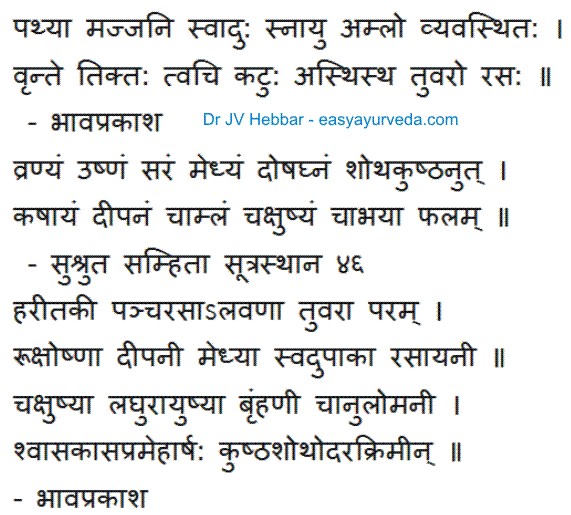
Qualities of different parts of fruit
- Hareetaki seed kernel is sweet
- Fiber part is sour
- Fruit rind is bitter
- Fruit Skin is pungent
- Seed is astringent in nature
- Fruit Pulp (majja) – Good for eyes, heavy to digest, balances vata and pitta dosha.
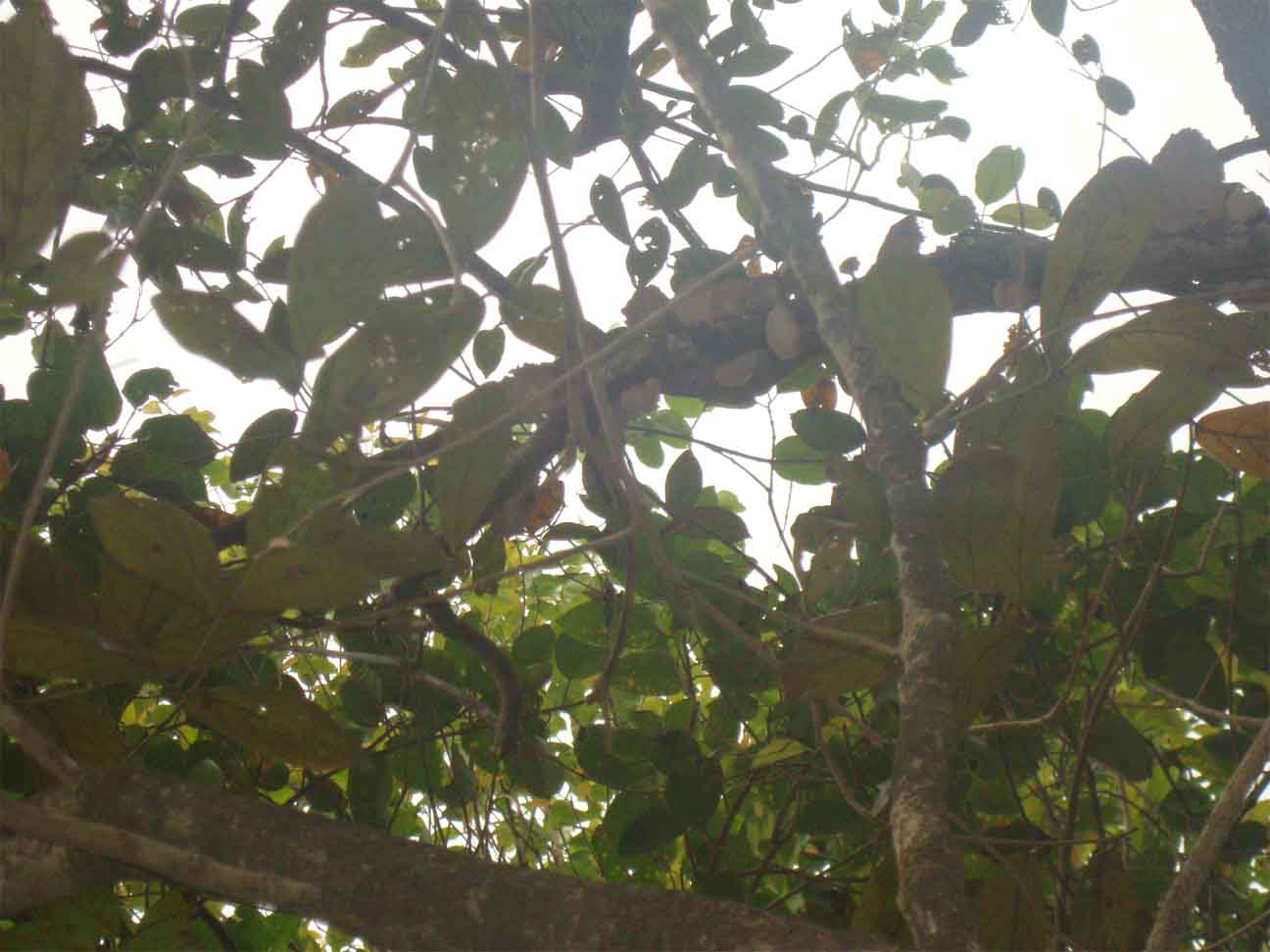
Morphology, Distribution
Morphology
Terminalia chebula is a medium sized deciduous tree growing up to 30 meters in height. Leaves are alternate, sub-opposite, oblong-ovate, with an acute tip, cordate at the base. They are glabrous above with a yellowish pubescence below. Fruits are drupe-like, glabrous, smooth, ellipsoid to ovoid in shape, yellow to orange brown in color with five longitudinal ridges. Flowers are monoecious, dull whitish yellow in color with strong unpleasant odor. Seeds are globose, pale yellow in color.
Distribution
Terminalia chebula Retz is found throughout South and Southeast Asia including India, Sri Lanka, Bhutan, Nepal, Bangladesh, Myanmar, Cambodia, Laos, Vietnam, Indonesia, Malaysia, Pakistan and Thailand.(b)
Haritaki Remedies
- Stomatitis, Dental caries – Cold infusion of haritaki fruit is used for gargling
- Bleeding gums – Fine fruit powder is used for application.
- Dysentery – 5 grams of stem bark powder is mixed with 50 ml of ferula seed soaked water. This mixture is consumed two times a day for two days.
- Stomach ailments in Children – 10 grams of fruits are taken and crushed with water and paste is made. This paste is given orally two times a day for 3 days
For stomach cleansing, the decoction / herbal tea of Haritaki, called Kadukkai Kashayam is given to children and also to adults on empty stomach early in the morning, once in 2 – 3 months. For this purpose, 10 grams (1 tablespoon) of haritaki powder is boiled in 2 cups of water and reduced to half a cup. For adults, 25- 50 ml of this is given and for children above 7 years of age, 5-10 ml of this is given. - Leucoderma – 15 grams of seeds are crushed in 25 ml of water and made into paste. This paste is taken once a day for a week.
- Eye ailment – Fruit extract is used to wash in watering eyes. Fruit powder soaked in water overnight in an earthen pot is used the next morning for eye wash. Fruit paste mixed with turmeric powder is used as a remedy for inflammation of eyes.
- Burns – Fruit paste can be applied on burns.
- Diabetes mellitus – Two spoons of dried powder with water are taken once a day for 20 days. One fruit per day is eaten for 30 days. Leaf juice 1 teaspoon is consumed once a day for 2 months.
- Sore throat – Fruit roasted a little on burning charcoal is chewed.
- Cough – Fruit powder mixed with the water or cow’s or goat’s milk is taken twice a day for 7 days. Fruit is roasted and chewed for instant relief.
- Tuberculosis – 5 grams of fresh bark is crushed with 1 gram of black pepper is taken orally at noon.
- Obesity – Haritaki fruit consumed for a few months is used as a remedy for obesity and improves body strength.
- For black hair – Fruit bark is mixed with equal quantities of stem bark of Shorea robusta, fruit bark of Terminalia bellirica and stem bark of Syzygium cumini and crushed. This is applied on hair for 2 -3 hours before hair wash. (a)
Chemical Constituents
Terminalia chebula contains chebulagic acid, chebulic acid, tannic acid, gallic acid (~1.2%), ethyl gallate, ellagic acid, chebulinic acid, chebulanin, corilagin, terflavin A, punicalagin, terchebulin, casuarinin, 2,4-chebulic-β-D-glucose and glucose esterified with gallic acid to various degrees (eg.,1,6-O-galloyl-β-D-glucopyranose), Hydroxy anthraquinones glycosides etc
Haritaki in hemorrhoids
Use of Haritaki in hemorrhoids – Harad helps to ease bowel movement, one of the complications in hemorrhoids. It helps in reducing the pile mass and reducing / stopping the bleeding.
A sitz bath with – 2 tablespoons of Haritaki or Triphala powder, in half a bucket of water, for 10 minutes, before bath, is useful in reducing the swelling and promotes healing.
Kushtahara – Useful in skin diseases
Shothahara – relieves inflammation
Udarahara – useful in ascites
Krimihara – useful in worm infestation
Harad for splenomegaly
For the treatment of splenomegaly (Plihodara), Harad, in a dose of 3 – 5 grams once or twice a day, is administered along with 2- 3 grams of jaggery (Guda). (Charaka Samhita Chikitsa Sthana 13)
Hareetaki for prolapsed uterus
Being a mild laxative, it helps to evacuate bowels without much pressure on the uterus.
It is astringent. Hence, water decoction of Haritaki is used for washing the prolapsed part of the uterus.
Triphala Kashaya is also used for the same purpose.
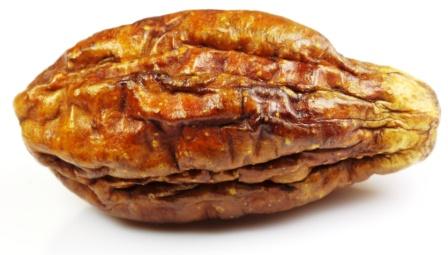
Effect on Tridosha
Haritaki balances all three doshas – vata, pita and kapha
Because of its sweet, bitter and astringent tastes, it balances Pitta
Because of its pungent, bitter and astringent taste it balances Kapha
and because of its sour taste, Terminalia chebula balances Vata.
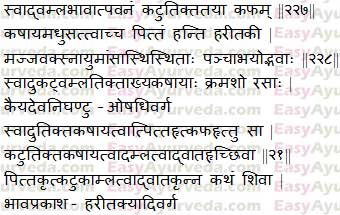
Harad with cow urine
पीतं कफोत्थं शमयेत्तु शोफं गव्येन मूत्रेण हरीतकी च||२१||
pītaṃ kaphotthaṃ śamayettu śophaṃ gavyena mūtreṇa harītakī ca||21||
In Kaphaja Shotha – Edema, inflammation disorders due to Kapha dosha aggravation, cow urine is administered along with Haritaki. Charaka Chikitsa Sthana 12th chapter
Harad with hot water
1 – 3 grams of Harad is administered with a cup of hot water to relieve Ama (altered digestion and metabolism) in case of Irritable bowel disease, associated with low digestion strength. – Charaka Chikitsa Sthana 15th chapter.

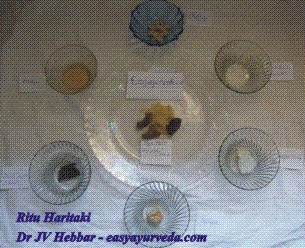
Ritu Haritaki
Also known as Rutu / Rtu Hareetaki.
For the purpose of Rasayana (rejuvenation, anti aging),
Haritaki is taken along with different ingredients in different seasons. This regimen is called Ritu Haritaki. Ritu means seasons.
Varsha Ritu – In the rainy season, Harade is given along with Saindhava – Rock Salt.
Sharat Ritu – In Autumn, it is given along with Sharkara – sugar
Hemanta Ritu – In early winter, it is given along with shunti (ginger)
Shishira Ritu – In winter, it is given along with Pippali – Long pepper – Piper longum
Vasanta Ritu – In Spring, it is given along with Madhu (honey)
Greeshma Ritu – in summer, it is given along with Guda (jaggery)
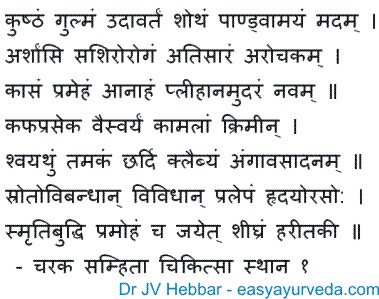
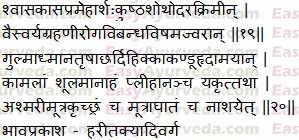
Medicinal uses
Chebulic myrobalan is useful in
Kushta – skin diseases
Gulma – Abdominal tumor, bloating
Udavarta – bloating of abdomen
Shotha – inflammation
Pandu – Anemia, initial stages of liver diseases
Mada – delirium
Arsha – hemorrhoids
Shiroroga – diseases pertaining to head, headache
Atisara – diarrhea, dysentery
Arochaka – anorexia
Kasa – cough, cold
Swasa – breathing difficulties
Prameha – diabetes, urinary tract disorders
Anaha – bloating
Pleeha – splenomegaly
Nava Udara – early stages of ascites
Kaphapraseka – increased salivation due to Kapha dosha
Vaisvarya – hoarseness of voice
Kaamala – jaundice
Krimi – worm infestation, infection
Shvayathu – edema, inflammation
Tamaka – asthma
Chardi – vomiting
Klaibya – impotency
Angavasada – body ache
Srotovibandha – obstruction to body channels, constipation
Pralepa, Hrudayoraso – stiffness of chest, heaviness of chest
Pramoha – delusion and lack of memory and intelligence
Vaivarnya – skin discoloration
Purana vishama jwara – chronic recurrent fever
Akshiroga – eye disorders
Hridroga – heart diseases
Grahani – IBS or sprue-syndrome
Shosha – muscle wasting (tissue depletion)
Vibanda strotasam – obstruction in body channels
Urustambha – thigh stiffness
Admana – abdominal distention
Vrana – wound
Vatarakta – gout
Mutrakrichra – dysuria
Hikka – hiccoughs
Kandu – itching
Yakrit – liver disorders
Ashmari – renal calculus
Mutraghata – retention of urine
Gut Cleansing
What is the ideal herb for gut cleansing?
Dr JV Hebbar
Gut cleansing means cleaning out the stomach, intestines, liver and pancreas.
There are many methods to do it –
Fasting – Not loading up the daily fuel gives rest to the digestive system and fine tunes its functions, fixes small issues related to the organs and makes it ready to go afresh.
Sometimes just fasting is not sufficient to cleanse and detoxify the gut. We may need external force to flush out toxins and stimulate the digestive organs.
For this purpose, Ayurveda explains Panchakarma procedures – therapeutic vomiting, therapeutic purgation, enemas etc. But these therapies have to be done by expert Ayurveda practitioners in an Ayurveda center. These are good to undergo at least once or twice a day as these therapies do systemic cleansing and rejuvenate not only the gut but all the systems of the body.
Weekly or bi-weekly cleansing out gut toxins is required by most of us, as we have polluted the food that we take and have loaded them with chemicals and with unwanted genetic editing etc.
For this purpose, we need something which is safe,
which helps in rejuvenation – has anti aging (Rasayana) effect
which is mildly hot – so that it kindles digestion strength
which has mild laxative action without causing any twitching sensation of the stomach
which would not cause severe purgation which will be detrimental to health.
Which is good to take on all seasons.
Considering all these parameters, Haritaki (Harad / Chebulic Myrobalan) is the most ideal of all herbs for gut cleansing to be done by a common man.
It is good to take it once in 7 – 15 days, at night, 5-10 grams with 1-2 teaspoon of ghee – for Vata and Pitta persons
and with honey – for Kapha people.
But just before starting this regimen, consult a doctor and go ahead.
In case of extreme dryness, during pregnancy and in people with severe emaciation, there are some restrictions on haritaki usage.
Pharmacological Activities
Haritaki has antibacterial, antifungal, antiviral, antioxidant, anti cancer , hypolipidemic, antidiabetic, renoprotective, hepatoprotective, cardioprotective, immunomodulator, prokinetic and wound healing properties.(c, d)
Harad Murabba
Also called Harde Murabba, is a famous north Indian remedy prepared with Haritaki and jaggery / sugar syrup. It can be consumed on an empty stomach or before food once in a day. It can be taken two times a day after food.
It carries all the health benefits of Harde, listed below.
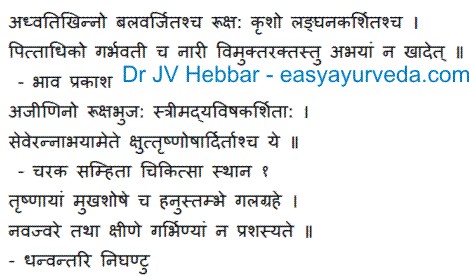
Haritaki – side effects and contraindications
Though Chebulic myrobalan has immense health benefits, due to its astringent and hot nature, it is contraindicated in a few cases.
Haritaki is best avoided in
Adhva Ati Khinna – people who have walked for very long and who are tired,
Balavarjita – Who have depleted immunity and strength
Rooksha (dry) – Who are feeling dry and are emaciated
Krusha – having lean body
Langhanakarshita – who have fasted for long
Pittadhika – In people with increased Pitta (burning sensation)
Garbhavati – in pregnant woman
Vimuktarakta – After bloodletting treatment, during and soon after menstruation
Kshut, Trishna, Ushnarta – who are having severe thirst, hunger and have got exposed to sunlight for a long time.
Ajeerna – in patients suffering from indigestion
Stri madya karshita – those who are emaciated due to increased sexual activity and alcohol
Mukhashosha – in people having dry mouth
Hanusthambha – in people with neck stiffness
Galagraha – in people with dry throat
Navajvara – in early stages of fever
Though there are a few nutritive health benefits, Haritaki is more of cleansing, moisture absorbing, weight reducing in nature. Hence it is advised to avoid Hareetaki during pregnancy.
In most of the contra indications explained above, dryness, lack of water supply – kind of symptoms are noticeable. Haritaki, already being astringent, is not advisable because it may further contribute to dryness.
Haritaki is best avoided in infants, up to 5 years of age. It should be given under medical supervision to children.
Single herb usage of Haritaki is contraindicated in lactating mothers. It may decrease breast milk production.
Harad in some people may cause abdominal pain. It is specifically found in people who cannot tolerate heat or people with extreme stomach sensitivity or severe gastritis.
Interaction with medicines, supplements
Can this be used while taking Homeopathic medicine?
Yes. This product does not react with homeopathic medicine.
Can this medicine be continued while taking supplements like multivitamin tablets, Omega 3 fatty acids etc?
Yes. Generally, this product goes well with most dietary supplements. However, if you are taking more than one product per day, please consult your doctor for an opinion.
With western
medicines
Seek your
doctor’s advice if you are taking this product along with other western
(allopathic / modern) medicines. Some Ayurvedic herbs can interact with modern
medicine.
If both Ayurvedic and allopathic medicines are advised together, then it is
best to take Allopathic medicine first, wait for 30 minutes and then take the
Ayurvedic medicine.
Dosage
1 – 6 grams of fruit powder along with required co-drink or ingredient, based on disease, once or twice a day, in single or divided dose, as per discretion of Ayurvedic doctor.
With milk: Harde can be taken along with milk. Milk is a coolant and would negate the slightly hot effect of Haritaki. But this combination might enhance the laxative effect of Haritaki.
Haritaki Murabba: Murabba is made by dipping the fruits in a sugar syrup. it becomes soft and tasty. It is often used as a condiment for daily use. Haritaki Murabba contains all the natural benefits and has more nutritious value. It can be eaten as it is, followed by a cup of water or milk. If the Harar Murabba contains excess salt, then it is better to avoid milk.
Haritaki based on season
I live in the UK and seasons are different(now -1ºC), how can I determine which combination to take with Haritaki ?
If it is rainy season, then you can consume Haritaki with rock salt,
During the early part of winter, you can consume it with ginger, during winter consume it with long pepper, post winter season – with honey, during summer along with jaggery. If you think that this system cannot be followed, you can take Haritaki with just honey or long pepper.
Harad for chronic oral ulcers
Dr Nayyar Mumtaj, Pakistan –
Dr JV Hebbar I’m a Homeopathic doctor in Pakistan but I also use herbals. I would like to share my personal experience. Few years back I had a mouth ulcer ,Which remained with me for more than four years. I did use a lot of Homeo, Herbal, and English medicines, and took allergy vaccination. I consulted dental, skin, and many other specialists but got zero results. I could not eat chili the whole time. Some said it’s bacterial, some said it’s viral and some said that it was fungus. One day I met a baba (old man). He suggested that I chew bari Harir (a herb) also called Harar in Urdu. I used that and got 100% relief within 7 days. Its use is very simple – just to chew it and spit it 4-5 times a day. I would like to share it with other needy persons to get relief.
How to consume Hareetaki for constipation?
Question: I have chronic constipation and I have been taking Softovac sugar free powder but the problem is I feel like going to the toilet at 12.30 in the afternoon with whatever method I try. Can you tell me a method by which I will be able to go to the toilet at 8.00 am in the morning with any medicine without side effects.
Answer:
Let’s consider a few factors.
The person is having chronic constipation. So, whatever the herb that we choose, the person should be able to use it for quite a long time. Hence, Haritaki – Terminalia chebula, chebulic myrobalan is very useful in this regard. It has Rasayana – rejuvenating, anti aging effect. So, its good for long term use.
The patient is already using a laxative, but it is yielding the result next afternoon.
Hence, if we administer Haritaki at night, chances are there that the patient will have motions quite late in the day.
Haritaki is a bit milder when compared to other laxatives. The words – Anulomani and Mala Shodhani are used to describe the qualities of Haritaki.
Hence, it makes sense to administer Haritaki churna – half to one teaspoon in the afternoon and at night, after food.
The exact dose between half – 1 teaspoon should be decided based on the patient’s age, weight and seriousness of constipation problem.
Why after food? Because, in the context of Haritaki, Bhavaprakasha book uses the term – Bhuktasyopari Yojita.
Anupana – co drink
If the patient has Kapha symptoms such as obesity, vomiting sensation, heaviness of abdomen, anorexia, excessive salivation, then it is administered with a pinch or two of Saindhava Lavana – rock salt.
If the patient has Pitta Symptoms such as burning sensation in chest and abdomen, then it is administered with a teaspoon of sugar candy powder.
If the patient has Vata symptoms such as bloating, gas etc, then it is administered along with half to one teaspoon of ghee (clarified butter).
The other alternative to administering it in the afternoon and night is to administer a higher dose at night.
Having said that, Haritaki comes with some contra indications such as – it should be avoided during pregnancy, in very lean persons, who have been emaciated due to heavy work or exercise etc. which I have explained in the article above.
Dry Vs Fresh fruit
द्राक्षाबिल्वशिवादीनां फलं शुष्कं गुणाधिकम् ||५१|| – Bhavaprakasha.
drākṣābilvaśivādīnāṃ phalaṃ śuṣkaṃ guṇādhikam ||51|| –
In the case of grapes, bael fruit and Harad fruit, the dried fruits are better than the fresh.
Haritaki for hemorrhoids
The powder of Harad fruit is made into a paste with equal amounts of jaggery. This is administered before food to reduce pain, itching and the size of hemorrhoids.
Harad along with buttermilk is administered for piles. (Charaka Chikitsa Sthana 14th chapter).
Chebulic myrobalan for diarrhea
In the initial stage of Diarrhea (Atisara), which is not associated with Ama (impaired digestion and metabolism), Haritaki is administered due to its hot potency and mild laxative action. This helps to evacuate morbid Doshas out of the body and brings about lightness to the colon and to the body. By this, the disease gets cured. – Charaka Chikitsa Sthana 19th chapter, Ashtanga Hrudaya Chikitsa Sthana 9th chapter
Harad for vomiting treatment
Kapha and Pitta chardi (Because the Doshas are aggravated in excess)
Along with honey, the powder of Abhaya – Terminalia chebula is given in a linctus form for the purpose of purgation. – Virechana treatment.
Effect of Haritaki on Sex
Haritaki has a mixed effect on sexual health.
a. It has Rasayana – anti aging property. Almost all herbs with Rasayana property also possess aphrodisiac nature. So, Haritaki, in a small dose of 1 – 2 grams per day, for a period of 1 month increases sexual energy.
b. Haritaki has astringent properties. This is useful in treating excess night-fall, wherein a person loses some quantity of semen every day (night).
c. But on long term usage, because of its hot and astringent properties, Haritaki may cause a decrease in sexual strength. That is why it is contraindicated in those who are emaciated due to increased sexual activity and alcohol.
So the bottom line is, Haritaki is useful in treating premature ejaculation and nocturnal emission. But Harad is better to avoid in case of low semen volume, low sperm count, low sexual mood and erection problems.
7 types of Haritaki
Although Bhavaprakasha has explained seven types of Haritaki, all are the same Terminalia chebula, available in different places. The seven types explained are –
Vijaya – used in all diseases, has a pedicle that resembles alabu and is available in Vindhya mountains.
Rohini – fruit is circular in shape – Useful in wound healing – available in a place called Pratishtanaka.
Putana – Having small fruits with big seed and thin skin – used for external application, available in Sindh area.
Amruta – Is huge, having thick fruit pulp, useful for Panchakarma (detoxification) , available in Champa, Bhagalpur area.
Abhaya – Having five creases in fruit skin, useful in ophthalmic disorders, available in Champa, Bhagalpur area.
Jivanti – Yellow colored fruit – useful in all diseases, available in Saurashtra region of Gujarat.
Chetaki – Having three creases in fruit skin, useful for purgation, available in Himachal Pradesh.
Of these seven types, Vijaya variety is considered as the best.
3 types of Haritaki
- Niraja
- Vanaja
- Parvatiya
Of these 3 varieties, parvatiya is considered as the best.
Market varieties
Small – Stone less
Yellow – Having stone but immature
Big – Fully matured
Habitat
Haritaki is abundantly found in North India, though it is distributed throughout India up to 5000 feet height.
How To Take Harad As Per Dosha And Diseases?
Harad is a very effective Tridosha balancing Ayurvedic herb. It has potent rejuvenative properties and laxative effects. Ancient text book – Bhava prakasha explains unique ways to consume Haritaki.
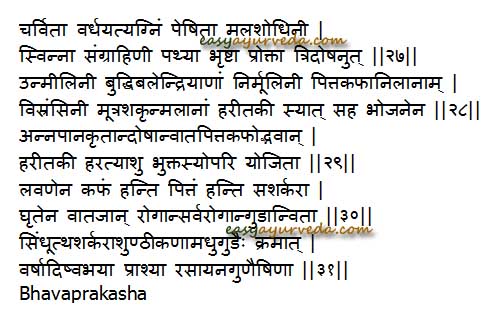
Reference: Bhavaprakasha nighantu – Hareetakyaadi varga –Verse no-30
Consumed by chewing -> improves digestion strength
Made into a Paste with Water & Consumed -> Mala Shodhani (Laxative)
Consumed After Cooking/Steaming -> Absorbent (Grahi) – useful in malabsorption syndrome.
Fried (with oils & fats) -> Tridoshahara – Balances all 3 Doshas
Here frying refers to taking out the excess moisture from the drugs. Or else we can also extend to the applied aspect as frying with respective oils or ghee which have respective Dosha pacifying effects. In Vata associated conditions it can be fried with sesame/castor oil, pitta associated cases with ghee and mustard oil in case of Kapha predominant conditions.
Harad along with food -> expels out Doshas
Taken After Food -> Useful in Food Toxicity – it helps to eliminate all toxic effects due to food poisoning.
Lavana – rock salt -> balances Kapha Dosha
Sharkara – Sugar Candy -> balances Pitta Dosha
Ghrita – Ghee -> balances Vata Dosha
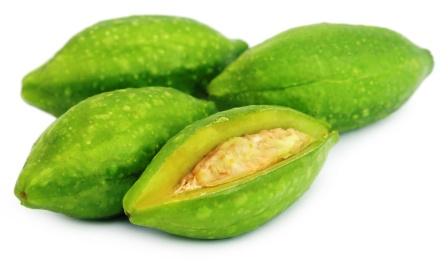
Rationality:
When the Hareetaki fruits are masticated it gets into the contact of saliva and hence various relative digestive enzymes. This in turn facilitates the digestive fire. When Harad fruits are taken by making into fine paste it partially mixes up with the water and hence it moves downwards in lesser time and hence imparts laxative benefits. Usually the retention period in the stomach and small intestine will be less in such cases. When the fruits are cooked, few of the laxative principles are reduced and in turn due to tannin (kashaya rasa /astringent predominant) it acts as absorbent (grahi) and hence the food withstanding capacity of the intestine is gradually increased. Due to the synergistic properties undoubtedly Tridoshahara action can be enjoyed from the drug, if fried or heated with specific oils / fats.
Therapeutic application
If the above unique and specific classical principles are applied, the drug Hareetaki and its derived formulations can be used with wider application.
For example,
If a patient is suffering from skin disease, the individual is of vata or kapha constitution, has lesser digestive capacity, it is better to administer the formulation Triphala choorna which is well indicated in this condition, by mastication or by proper chewing. The same is applicable in stomatitis/ mouth ulcer also.
This can be extended to the formulations like
Dashamoola hareetaki
Kamsahareetaki,
Vyaghree hareetaki,
Bhrugu hareetaki lehya preparations also.
Making the drug into fine paste and then administering it, serves as a laxative. So, Hareetaki alone or Hareetaki predominant drugs like Triphala choorna, Pathyadi choorna, Saptamrita loha etc can be taken in the form of fine paste or immediately after the intake of powder medicaments, water can be administered for the same effects/benefits.
Well cooked Hareetaki formulations have the ability to control intestinal motility. This can be effectively obtained by the physicians by recommending the relative formulations like Dashamoola hareetaki, Dhatryavaleha etc in diseased conditions like Irritable bowel diseases, Malabsorption syndromes, intestinal flatulence, abdominal distention, mal digestion, abdominal colic etc.
Eranda taila bhrishtha hareetaki (fried in castor oil) pacifies both Vata and Pitta associated conditions or where the intestines have developed dryness due to improper food and habits, chronic diseases, malnourishment, dominant vata, tissue damage associated conditions etc.
Proprietary Ayurvedic medicines with Haritaki as ingredient:
Defet-5 Capsule – It is manufactured by Ayulabs Pvt Ltd, Rajkot, used in the treatment of obesity and high cholesterol.
Best Quality Haritaki
The qualities of Best haritaki (ref – Bhavaprakasha Nighantu) –
The haritaki fruit which gets ripened in the tree and then fall down, new, unctuous, thick (ghana), Circular (vrinta), Heavy, that which sinks when dropped in to the water and which weighs about 24 grams (dwikarsha) is considered as possessing the best quality.
Features of Bad Quality Haritaki
Fruit which is infested by insects or worms, burnt, that which is found in muddy water or saline soil and which is broken is considered of bad quality.
Research
Anti-diabetic, Reno-protective Activity – A research study done to investigate anti-diabetic activity of the chloroform extract of Terminalia chebula seed powder has proved its significant anti-diabetic and renoprotective activity.
Anticancer Activity – A study conducted on ethanolic gall extract of Terminalia chebula to evaluate its anti cancer property has come to the conclusion that ethanolic leaf gall extract of T. chebula possess significant cytotoxic activities.
Sanskrit Synonyms
Hareetaki, Abhaya, Pathya, Kaayastha,
Pootana – Cleanses the body
Panchabhadrika – It has five tastes
Amrita – Protect from old age disorder
Haimavati – Grows in Himalaya
Avyata – Relieves pain
Chetaki, Shreyasi, Shiva, Vayasta, Vijaya, Jeevanti, Rohini
Prapathya, Kayastha, Pranada, Jaya, Nandini, Jivapriya, Jivanika, Bhishakvara
Jivya, Devi, Divya
Categorization
Classical Categorization
Bhavaprakasha Nighantu – Haritakyadi varga
Dhanvantari Nighantu – Guduchyadi varga
Raja Nighantu – Aamraadi varga
Kaiyadeva Nighantu – Aushadhi varga
Scientific Classification
Kingdom – Plantae
Division – Phanerogams
Subkingdom – Angiosperms
Class – Monocotyledons
Subclass – Epigynae
Order – Scytaminiales
Family – Combretaceae
Genus – Terminalia
Species – chebula
Manufacturer:
Patanjali Divya Haritaki Churna – manufactured by Patanjali Ayurved Limited.
Vernacular names
Hindi name – Harad, Harade, Harde, Har, Hare, Harra
English name – Chebulic Myrobalan
Bengali Name – Haritaki, Baalharitaki, Hatitaki gacha, Narra
Telugu name – karakkaya, Karakachettu, Karakaapa
Tamil name – Kadukkai, Karakaiya, Kadukemar
Gujarati name – Harade, Himaja
Marathi name – Harada, Hirad, Harade, Hartaki, Haradi, Balaharadi
Arabian name – Haleelaz
Farsi name – Haleel
Kannada name – Alale Kayi, Anilaikayi, Anniley, Anile
Malayalam name – Katukka
Konkani name – Ordo
Manipuri name – Manahi
Assamese name – Hilika
Sthanika Karma (Systemic Action)
External application
Anti inflammatory, Analgesic in action. Cleanses the wounds and promotes faster healing. In eye disorders it can be used for external application. Decoction is used for wound cleaning. For mouth and throat diseases decoction is used for gargling.
Internal administration-
Nervous system – strengthens the nervous system, promotes the health of sense organs, especially strengthens nerves related to vision. Indicated in diseases of vata origin.
Digestive System – Carminative, digestive, Liver stimulant, Mild purgative, Anti helminthic. (Swinna haritaki is absorbent in nature). Indicated in Loss of appetite, Abdominal distension, Helminthiasis, Ascites, Hemorrhoids, Jaundice, Abdominal colic, malabsorption syndrome etc. It is highly recommended for srotosodhana (Cleansing the channels).
Respiratory system – Pacifies kapha dosha. Indicated in rhinitis, breathing disorders, Hoarseness of voice, cough etc.
Circulatory system – Indicated in rheumatic joint disorders. indicated in edema, blood borne diseases etc.
Reproductive system – Aphrodisiac, Helps to retain pregnancy. Indicated in uterine weakness, leukorrhea, Sukrameha, inflammatory diseases related to female reproductive tract etc.
Excretory system – increases urine output. Indicated in Dysuria, Renal calculi, UTI etc.
Satmikarana – Indicated in animal poisoning, facture, wounds etc.
Tvak – Indicated in skin disorders
Satmikarana – Rejuvenative
Tapakrama – Indicated in fever (Vishamajvara and jirnajvara)











110 comments
Dr J V Hebbar MD(Ayu)Author
Please consult an Ayurvedic doctor directly. You might be having cystic acne, which requires treatment.
The second remedy that you’ve described looks good to relieve gastritis, useful for diabetes and also to lose weight, to some extent.
Chandrasekhar
i read that commercially prepared ayurvedic medicines have lead residues and believe they could be due to processing. Hence decided to make triphala churna myself and purchased amla, haritaki and vibheetaki from the market. I believe they should be washed and deseeded before powering. Is that correct?
Dr J V Hebbar MD(Ayu)Author
Available online from any country. Search for Triphala
Henrietta
Thank you Dr, Hebbar, I will do that!
Hari
Can Triphala be used for Leaky Gut Syndrome and sensitive GI ??/ Pls reply
Fearless
Can terminalia chebula be used during pregnancy to support immune function in a mother that has lyme disease who makes sure to eat a well balanced diet and has her weight under control? I take it on a daily basis now and it works wonders for my energy and I would hate to give it up.
Nisrin
Past 2 months I have got slip disc due to whichmy left side nerve is getting compressed there by leading to pain in my left leg and numbness in my feet. One of my friend told me to take zandu haritaki churns half a tea spoon empty stomach with warm water.To my surprise it is working wonders and my pain is getting lesser day by day .Can u please explain how? Should I continue ? And till when.
Dr J V Hebbar MD(Ayu)Author
Haritaki causes mild form of virechana – mild purgation, which helps to reduce Vata, hence it might be causing pain reduction in you.
Savitha
Sir am 5 months pregnant.i have severe constipation.am using an ayurvedic laxative consists of senna and haritaki since 1week.is it safe or i need to discontinue
Dr J V Hebbar MD(Ayu)Author
Hi, Haritaki is not good for more than a month use during pregnancy.
Dhanraj
Hi, sir What is the use of the seeds of Haritaki. Is it waste or it can be useful. Please suggest me if any and one more thing can we eat 1 Haritaki fruit per day.
Dr J V Hebbar MD(Ayu)Author
I do not know of any use of its seeds.
Henrietta
Very good article, although I may have to google some of the words, like for instance, what is “jaggery”?
Dr J V Hebbar MD(Ayu)Author
Jaggery is the brown coloured unrefined, non centrifuged sugar. It is a product of concentrating cane sugar.
Vishal Lalka
whether the content of Haritaki is Harde or Himmaje
Dr J V Hebbar MD(Ayu)Author
It is Harde
Sudhakar Bhat
Hello Doctor, Greetings! When Jivanti – harad is useful in all diseases why Vijaya – harad is considered as best???
Dr J V Hebbar MD(Ayu)Author
Hi, whatever the type, Terminalia chebula is generally used as Harad. I do not see any difference.
Tonny
Is there any side effects for Use harad in diabetes
Dr J V Hebbar MD(Ayu)Author
No. It actually helps in diabetes.
Atmaram yadur
The Information is very useful .Dr Hebbar is doing a very good Job for the mankind.I am also a follower of Ayurvedic medicines .I have cured some People who had lost hope after spending lot of Money to Allopathic doctors .The allopathic doctors had told them that there is no cure any more for septic ears after doing three operations with no result.
Rakhi Baldi
what is Terminalia chebula, Linn ?
Dr J V Hebbar MD(Ayu)Author
Hi, it is same as Terminalia chebula – Haritaki.
Ashwin Patel
Dr Hebbar, Is there an Ayurvedic equivalent to Leaky Gut Syndrome?
Dr J V Hebbar MD(Ayu)Author
Hi, so far I have not come across any condition explained in Ayurveda as similar to symptoms of leaky gut syndrome.
Anoop
Dr. Hebbar,
I am wondering if the conditions explained in Ayurveda such as Duodenal ulcers/Peptic ulcers/Stomach ulcers (not sure about what they are called in Ayurveda) can be compared to symptoms of leaky gut syndrome?
Dr J V Hebbar MD(Ayu)Author
No. They cannot be compared to leaky gut syndrome.
Marcin
Great informative article! Thanks.
Priya
How to reduce weight
Dr J V Hebbar MD(Ayu)Author
Read about it here – https://www.easyayurveda.com/2009/09/24/simple-effective-tips-to-lose-weight-quickly-the-ayurvedic-way/
Andy
Could this Harad(powder) be put to use for skin disease- Vitiligo?
Dr J V Hebbar MD(Ayu)Author
Like I have mentioned in the article, taking Haritaki is contra indicated during pregnancy.
Having ginger powder – half – 1 gram two times a day with hot water looks a better option.
Dr J V Hebbar MD(Ayu)Author
There are many medicines such as Brahmi Ghrita, Saraswatarishta etc., Consult an Ayurveda directly for right advice and treatment.
Tanmoy
I have 4th stage piles and since last 7 days ,mass piles had emerged as a large chunk and pain continues from morning to night.I had previously medicated in homeopathy for last 1year but it cured for some time(4 month) but again it appeared with full action and I could not able to sit anywhere and also couldnot walk.I had tried ayurvedic medicine(given by ayurvedic doctor) for last 7 days but result is none.What should I do next to relief?(Age 24 year)
Dr J V Hebbar MD(Ayu)Author
Hi, 4th stage piles is very difficult to treat even with Ayurvedic medicines. Consider surgery options.
Shravan CHowdhari
Hi Doctor, my father has low oxygen levels at times dips below 90 especially while sleeping (sleep apnea has also been diagnosed) . I have heard taking one tea spoon of Haritaki Powder everynight can help in increasing Blood Oxygen Levels? Can Hariaki Powder help or you suggest otherwise?
spavi
hi sir it is cure migraine are not….
Dr J V Hebbar MD(Ayu)Author
It is not a cure for migraine.
Flora
Good morning Sir, myself (38 yrs) my sons (8 and 6.5 yrs) are taking 1 Aerand Bhrust Harde tablet daily at night for past three – four days. we started the tablet as we had embarrasing gastric issues. But we are noticing that the flatulence is now a little more smellier and constipation has eased. Why is there a bad smell in the flatulence? how long should we take these tablets? is there any sideeffects for children and myself… Kindly advise
Dr Malini Bhat
Sir, No you cannot while taking Alcohol.
vijay sharma
Dr. ji, I have problem of IBS. Actually Mucus comes in my motion that’s why I want to take Haritaki. I drink alcohol in the Evening only that’s why I want to take haritaki (Choti Harad) in the morning. I know its very harmful after having alcohol.
Dr Malini Bhat
Instead of Haritaki go in for Ginger. For the freshest tea, grate a half-teaspoon of ginger into a cup, then pour in hot water, let it steep for 10 minutes, strain out the ginger, and drink the tea.
vijay sharma
Thanks for your reply. We can take this ginger Tea with milk or without milk?
Dr Malini Bhat
Without milk.
Dr Malini Bhat
Madam, It can be used the following way:
> TRIPHALA CHURNA – This should be taken regularly to remove the constipation. It should be taken with lukewarm water before going to bed.
HARITAKI – This is recommended when there is bleeding along with inflammation and pain. One teaspoonful with milk two or three times a day gives relief from the condition.
Charley
I have high blood pressure and was wondering if Harad is safe for me to take?
Sushma
How much quantity of Harde can be consumed per day/month for Kids and Adults?
Praveen Sasikumar
Is Hareethaki contains potassium..? As my mom is having issues with lungs and high co2 level in blood. At the same time she is having high potassium. I read some article that Hareethaki is good for detoxification. Any clue will be of great help.
Monika
is it the same Himej and Harad ? I saw both products
us rao
Will Karakkaya podi cures rheumatoid arthritis ?
u.s
U S Rao
Thank you Doctor for your valuable information and prompt reply
Regards – U S Rao
Dr Malini Bhat
You are welcome sir.
tanishqa
Dr can Harada been given to children who has asthma with dry cough most time and wheezing some times, how much and how to give please advice
Dr J V Hebbar MD(Ayu)Author
Hi, I do not think that Amla / Haritaki / Vibhitaki could have caused the throat infection. It is very unlikely.
Dr J V Hebbar MD(Ayu)Author
I have not found usage of Haritaki in food recipes in Ayurveda texts
Dr J V Hebbar MD(Ayu)Author
If you have IBS associated with constipation, only then you can use Haritaki powder – 5 grams, along with warm water at night after food for 2 months time. This will also help in reducing cholesterol / triglycerides.
Dr J V Hebbar MD(Ayu)Author
Hi, it is not related to Haritaki powder. If you have doubts, please stop it immediately and consult an Ayurveda doctor immediately.
Hiren Chhatbar
Hello Sir,
I have been taking “Harde” for 1.5 yrs but recently, I came to know that anything which is “Rechak” i.e. laxative is not good in long term. So considering that, I have reduced its usage on daily basis. Can you please guide and explain any side effect of using “Harde” for long term like 10 yrs or may be 20 yrs. Some people also argue that it is like drug and you will be used to it. After using it 1.5 yrs, I experienced that it cleans my stomach every morning perfectly and also it seems to be keeping me healthy. But for long term, doubts are raised with different opinions of people.
Please guide.
Thanks,
Hiren Chhatbar
Dr J V Hebbar MD(Ayu)Author
Hi, Haritaki is not rechani (purgative). It is just Anulomani (mild laxative). Hence, I do not see any problem in taking it for 1.5 years.
But its long term use in excess quantity may cause dryness of body and skin. I would not recommend any herb for long term use – for 10 – 20 years unless it is absolutely necessary.
Poobie Pynie Moodley
I Vigay the best way to stop alcohol is to join alcoholic anononmous I did and am enjoying a new life
IS
I have been taking haritaki agastya rasayanam for past 2 months for chronic cough. Cough has reduced considerably. But I lost 5 kgs weight in 2 months. Should I continue or stop.
Dr J V Hebbar MD(Ayu)Author
Dear sir, considering your age, it is best for you to consult an Ayurveda doctor directly. Generally speaking, Divya Churna can be continued for 2 months time. Then after the dose needs to be gradually reduced.
Shubham Bhatla
Virya is sheeta of hritki
Dr J V Hebbar MD(Ayu)Author
Hi, Veerya of Haritaki is ushna.
Here are a few references to prove it –
1. In contra indications of haritaki, Bhavaprakasha has mentioned – Pittadhiko. Means, in people with Pitta dosha increase, avoid Haritaki. Pitta is hot, Haritaki is hot. So, it will further increase Pitta.
2. Chewing the Haritaki fruit causes increase in digestion power. – Whichever increases digestion power is naturally hot.
3. As per Sushruta Samhita 4th chapter, Haritaki is Vranya – useful in quick wound healing and Ushna – hot in potency.
SM
I took haritaki powder one pinch directly in my mouth to control cough. I got mouth ulcers. Is that not the correct way to instantly contol vough with haritaki powder ?
Dr J V Hebbar MD(Ayu)Author
Hi, haritaki is not so hot to cause mouth ulcers. Consider mixing it with honey or ghee before taking it.
Rajkumar Madan
skin disease like ring cutter can can be cured by small harad
Girishbhai.n. suthar
Sir I suffers with constipation my intestines sluggish can haritaki tab helpful?
Dr J V Hebbar MD(Ayu)Author
Hi, it does not affect the chances of pregnancy. But if you are taking it for 18 months, I think it is best to give a gap of 2 months, before continuing it again.
Balaji Reddy
To avoid any side affects (for adults), the great sidhar “Thirumoolar” advised to take for one mandal (48 days) in a sequence of ginger in morning, dried ginger in afternoon and Haritaki before bed. Making it a powerful combination to rejenuvate the whole body system.
Dr J V Hebbar MD(Ayu)Author
Thanks for the valuable inputs.
Ravi
what does Ayurveda say about the time ,place, quantity and use of Attars ? Is there a diagram or picture based on marma points as to what attar is used where ?
Dr J V Hebbar MD(Ayu)Author
There are mention of usage of Gandha Dravyas, used in the form of garlands. But Attar, I have not found direct reference or usage on specific marma points. If someone has found the reference and wishes to write an article, I will be happy to pay for the article and publish.
S
Hello sir
Is it safe to use both haritaki and tripalasudana at the same time or at the same day
Or which is best to use at a time?
Kindly guide me sir
Dr J V Hebbar MD(Ayu)Author
Both can be used together, if they are not causing diarrhea.
batikan
Hello. Thank you for the article. Can you suggest a brand to buy a good Haritaki Powder? I am trying to buy one to try now. Thank you
Neha
I am trying to conceive & taking this pill every night from 1 month. is it any effect ? will i avoid this medicine?
Dr J V Hebbar MD(Ayu)Author
This can be taken while trying to conceive. Stop it after conception is confirmed.
Sandy
Hello Sir, I would to take Haritaki in powder form as mentioned above for different seasons. Can you please suggest at what time in a day should i take it and how much/how many times (basically dosage)? I drink milk at night, so, does this sound right if i take it before milk? Can you please help?
Thank you.
Dr J V Hebbar MD(Ayu)Author
Basic dose is – 5 grams.
Preferred time is at night, after food.
You can drink milk after taking Haritaki.
Amit Singh
how and when to take haritaki ??
ie after meals or before
at night or in mornig ???
plz reply sir .
Dr J V Hebbar MD(Ayu)Author
Generally, at night, 20 minutes before meals.
harpal
thanks for the nice articles, in India where we can get authentic harad ie.if you can suggest how to practically tell which is the best harad(raw); also if any particular company which makes good quality harad powder.
thanks
Ruchika
Sir in which conditions we should go for triphala in spite of haritaki
Aps
which type of haritaki is best ? I have heard long haritaki is the best one . Which is the Survari Haritaki ? Is it the long one ? Long ones is the most costly
Dr J V Hebbar MD(Ayu)Author
Hi, I am not sure if any of the types mentioned in texts are available now.
Fathima
Hello Doctor,
I have grade 2 internal piles. I have continuous constipation problem after my delivery. I do not prefer to go for surgery as treatment for piles which my allopathy doctor advised.
If i take any medicine like Pantop i do not get constipated. Is my problem related to upper gastro tract or lower abdomen problem.
Can u pls guide me what medicine should i take in Ayurveda to cure my problem.
Dr J V Hebbar MD(Ayu)Author
Depends on the dosage. If it is just 1 pinch for 3 times a week, then no problem.
shah
Ok Thank you Doctor J V Hebbar. Will Haritaki also cure if any minor ulcer in the stomach? Thanks!
Ajay Sethi
Sir I’m having Kali harad daily approximately 20gram is it harmful to have
ihrjordan
Hi is haritaki useful for one who has overslept?to regain strength from blocked channels and restore bowel movement normalcy?
Ivana
Dear Doctor,
Please advise!
I have swallowed haritaki capsule and it got stuck in my esophagus. I ve been trying for hours to wash it down with water and bread but it doesnt work. Can you please tell me should I see a doctor? Or wait till it desolves? Is this dangerous for esophagus?
Thank you very much for your response!!
Kind regards!
Rashmi Chodda
My father is 88. His stomach does not get cleared in the morning. He gets little stool and in the evening too it’s the same. He feels unrelieved due to this. He wants that his stomach get cleared in the morning. How can he use harar murabba in this case? Shall he take with milk? Wud it be beneficial?
Siddhartha Gupta
I am 5 Feet 11 Inches and my weight is 71 KGs, Do I come in Lean category and should not have Haritaki ? Please Advice Sir
Dr J V Hebbar MD(Ayu)Author
If you do not have any constipation issue, there is no need to take Haritaki.
Siddhartha Gupta
That was not the question, it was a question regarding an article on this website. I think you should have Haritaki, it will sharpen your intellect.
Himanshu Bhatt
Dr. Sahab, I want to use Harad for reducing weight and cholestrol both. Request you to tell me the right dosage and right duration. Thank you in advance
Dr J V Hebbar MD(Ayu)Author
Better to take it for 2 months and then give a month gap and then continue again for 2 months. This way, it can be continued for long.
Dr J V Hebbar MD(Ayu)Author
Chebulic myrobalan or karakkaya
Chintan
Dear Dr
Most of the Haritaki powder sold in market do not mention the type of Haritaki used and whether it includes the whole fruit along with seed or just the outer layer skin. With different variety useful in different conditions, government should make it a rule to specify on the labels or is there any other way of knowing it while purchasing?
Chintan
Based on this article, the proper way of using Haritaki is the whole fruit including the kernel seed and not just the pulp. Whole fruit has more therauptic value.
https://www.ncbi.nlm.nih.gov/pmc/articles/PMC3336646/pdf/ASL-7-180.pdf
JA
Hi Doc, I am a patient with anal hematoma (which is now reduced) and i have terrible pain exactly at the start of having motions. Though my stool is soft, but the initital pain is severe the area around the anus hurts. I have been using aerand bhrust haritaki tablets during the night. 2 tablets. Is there a particular way this tablets needs to be consumed. How can the inital pain while passing motions reduce or stop. Please help me doctor..
balu
Hello Sir, Namaskara, can you please tell me when to take in a day the ritu haritaki?
Ria
Sir,
Is Haritaki advisable for people with chronic kidney issue. The kidney problem started because of taking too much diuretic… will haritaki/triphala be harmful in such condition,
Kaushal Shah
Sir, is Haritaki useful for oestro arthritis? What is the best form to take it and how long?
Megan Bester
Hello, I have Fibromyalgia and severe reflux issues and am on some very strong opioid based medication to treat this. I have recently started taking haritaki powder 3 days ago, and have noticed a marked increase in fatigue and some nausea, plus some agitation. I notice that haritaki is for detoxifying, and I wonder if it is causing me to detoxify from this medication and also increasing my fatigue which is a problem for me anyway but seems worse. Can you please tell me if these symptoms are likely to pass, or should I discontinue using haritaki? Thank you for your help.
Shyam jain
Hi her this is Shyam Jain here from Delhi.
Wanted to make haritaki Rasayana from, Ashtansamgraham shloka 19. It recommends haritaki from Himalayas. So which variety is Acharya Vagabhat is talking about out of the 7 varities?
Vaidyanath
For stomach cleansing during our childhood we used to be given in empty stomach in the early morning Kadukkai Kashayam. Is it possible to get now. What is the dosage
Dr J V Hebbar MD(Ayu)Author
One can make it at home. Formula for making kashayam is – 1 tablespoon of kadukkai powder, mixed with 2 cups of water. Boil and reduce it to half a cup and filter.
For children, regular dose of kashaya is 5 ml.
Dr J V Hebbar MD(Ayu)Author
Dried fruit, eaten by chewing – half to one fruit per day is good.